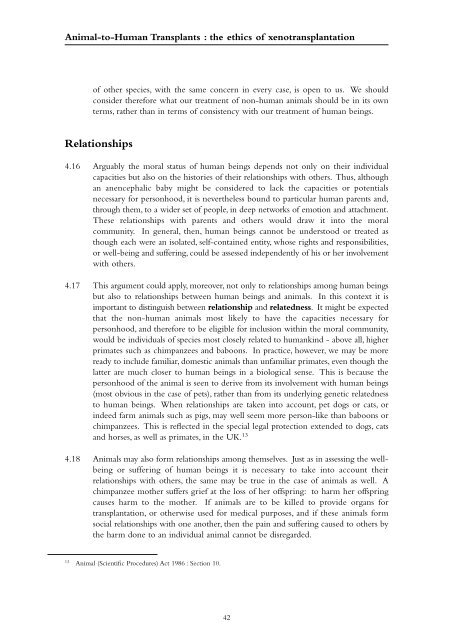Xenotransplantation - Nuffield Council on Bioethics
Xenotransplantation - Nuffield Council on Bioethics
Xenotransplantation - Nuffield Council on Bioethics
Create successful ePaper yourself
Turn your PDF publications into a flip-book with our unique Google optimized e-Paper software.
Animal-to-Human Transplants : the ethics of xenotransplantati<strong>on</strong><br />
of other species, with the same c<strong>on</strong>cern in every case, is open to us. We should<br />
c<strong>on</strong>sider therefore what our treatment of n<strong>on</strong>-human animals should be in its own<br />
terms, rather than in terms of c<strong>on</strong>sistency with our treatment of human beings.<br />
Relati<strong>on</strong>ships<br />
4.16 Arguably the moral status of human beings depends not <strong>on</strong>ly <strong>on</strong> their individual<br />
capacities but also <strong>on</strong> the histories of their relati<strong>on</strong>ships with others. Thus, although<br />
an anencephalic baby might be c<strong>on</strong>sidered to lack the capacities or potentials<br />
necessary for pers<strong>on</strong>hood, it is nevertheless bound to particular human parents and,<br />
through them, to a wider set of people, in deep networks of emoti<strong>on</strong> and attachment.<br />
These relati<strong>on</strong>ships with parents and others would draw it into the moral<br />
community. In general, then, human beings cannot be understood or treated as<br />
though each were an isolated, self-c<strong>on</strong>tained entity, whose rights and resp<strong>on</strong>sibilities,<br />
or well-being and suffering, could be assessed independently of his or her involvement<br />
with others.<br />
4.17 This argument could apply, moreover, not <strong>on</strong>ly to relati<strong>on</strong>ships am<strong>on</strong>g human beings<br />
but also to relati<strong>on</strong>ships between human beings and animals. In this c<strong>on</strong>text it is<br />
important to distinguish between relati<strong>on</strong>ship and relatedness. It might be expected<br />
that the n<strong>on</strong>-human animals most likely to have the capacities necessary for<br />
pers<strong>on</strong>hood, and therefore to be eligible for inclusi<strong>on</strong> within the moral community,<br />
would be individuals of species most closely related to humankind - above all, higher<br />
primates such as chimpanzees and babo<strong>on</strong>s. In practice, however, we may be more<br />
ready to include familiar, domestic animals than unfamiliar primates, even though the<br />
latter are much closer to human beings in a biological sense. This is because the<br />
pers<strong>on</strong>hood of the animal is seen to derive from its involvement with human beings<br />
(most obvious in the case of pets), rather than from its underlying genetic relatedness<br />
to human beings. When relati<strong>on</strong>ships are taken into account, pet dogs or cats, or<br />
indeed farm animals such as pigs, may well seem more pers<strong>on</strong>-like than babo<strong>on</strong>s or<br />
chimpanzees. This is reflected in the special legal protecti<strong>on</strong> extended to dogs, cats<br />
and horses, as well as primates, in the UK. 13<br />
4.18 Animals may also form relati<strong>on</strong>ships am<strong>on</strong>g themselves. Just as in assessing the wellbeing<br />
or suffering of human beings it is necessary to take into account their<br />
relati<strong>on</strong>ships with others, the same may be true in the case of animals as well. A<br />
chimpanzee mother suffers grief at the loss of her offspring: to harm her offspring<br />
causes harm to the mother. If animals are to be killed to provide organs for<br />
transplantati<strong>on</strong>, or otherwise used for medical purposes, and if these animals form<br />
social relati<strong>on</strong>ships with <strong>on</strong>e another, then the pain and suffering caused to others by<br />
the harm d<strong>on</strong>e to an individual animal cannot be disregarded.<br />
13<br />
Animal (Scientific Procedures) Act 1986 : Secti<strong>on</strong> 10.<br />
42
















